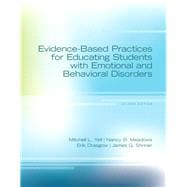This title is only available as a loose-leaf version with Pearson eText.
With an emphasis on effective instruction, the second edition of Evidence-Based Practices for Educating Students with Emotional and Behavioral Disorders uncovers the practices that are most effective for teaching students with EBD.
The text’s practitioner-friendly style places emotional and behavioral disorders within the context of the classroom and includes information on how to manage student behavior, teach students specific content areas, and develop educationally meaningful and legally sound IEPs. Chapters are filled with useful advice for teachers and cover important topics such as assessment, law, social skills training, and academic interventions.
0133386007 / 9780133386004 Evidence-Based Practices for Educating Students with Emotional and Behavioral Disorders, Loose-Leaf Version with Pearson eText -- Access Card
Package consists of:
0132657996 / 9780132657990 Evidence-Based Practices for Educating Students with Emotional and Behavioral Disorders Loose Leaf Version
0133394506 / 9780133394504 Evidence-Based Practices for Educating Students with Emotional and Behavioral Disorders, Pearson eText -- Access Card








